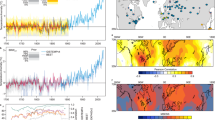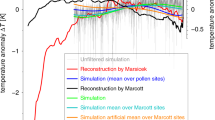Abstract
MANY theories have been proposed to explain the climatic fluctuations which produced the sequence of glacial–interglacial periods of the order of tens of thousands of years which have occurred throughout the Quaternary. These fluctuations represent temperature changes in the temperate regions of about 6 °C between a glacial and an interglacial situation. There are also climatic fluctuations with a period of the order of about a thousand years representing temperature changes of about 2 °C. These changes are believed to have had an important bearing on human history, but have been little studied because it is difficult to obtain accurate temperature records for past periods. Shorter temperature fluctuations of the order of a few decades, and representing temperature changes of perhaps as much as one degree, are of considerable economic importance and merge into the developing field of long-term meteorological forecasting. Considerable interest has recently developed in short-term climate changes. If detailed long-term climatic records could be obtained for extended periods in the past it might be possible to determine the causes for the climatic variation, and hence predict future climate trends. Even a knowledge of how hot/cold or dry/wet a particular region's climate could become, and with what probability, would be of considerable economic value to planners involved in hydroelectric development, irrigation schemes, snow clearance and the development of arid and polar regions. At present instrumental records have existed only since the mid-seventeenth century for central England, and for most other areas only over a little more than a century. Cave deposits (speleothems) provide stratigraphy which has a high inherent time resolution. Data for studying short-term temperature fluctuations can be obtained by measuring the 18O/16O ratio of suitable stalagmites1. This technique should enable a high resolution temperature curve to be produced for many regions of the globe. We report here an investigation on the 18O/16O profile through a New Zealand stalagmite which was undertaken partly to evaluate the feasibility of obtaining high time resolution data from speleothem material and partly to compare the temperature record from New Zealand (in the Southern Hemisphere and a region meteorologically unrelated to Europe) with the English climate curve, which is the most firmly established climate curve for the last millennium. Such proxy data given us the possibility of obtaining long-term high resolution temperature records from some of the critical regions of the world where meteorological records either do not exist or are of very short duration.
This is a preview of subscription content, access via your institution
Access options
Subscribe to this journal
Receive 51 print issues and online access
$199.00 per year
only $3.90 per issue
Buy this article
- Purchase on Springer Link
- Instant access to full article PDF
Prices may be subject to local taxes which are calculated during checkout
Similar content being viewed by others
References
Hendy, C. H. & Wilson, A. T. Nature 219, 48–51 (1968).
Wilson, A. T. & Grinsted, M. J. D.S.I.R. Bull. 220, 61–66 (DSIR, Wellington, New Zealand, 1978).
Emiliani, C. J. Geol. 63, 538–578 (1955).
Ferguson, C. W. Science 159, 839–846 (1968).
Hendy, C. H. in Radiocarbon Variations and Absolute Chronology (ed. Olsson, I. U.) 419–443 (Wiley, New York, 1970).
Garnier, B. J. The Climate of New Zealand (Edward Arnold, London, 1968).
McCrea, J. M. J. chem. Phys. 18, 849–857 (1950).
Craig, H. Geochim. cosmochim. Acta 12, 133–149 (1957).
Lamb, H. H. Palaeo 1, 13–37 (1965).
Trenberth, K. E. N.Z. Met. S. Misc. Pub. 161 (Wellington, New Zealand, 1977).
Burrows, C. J. N.Z. J. Geol. Geophys. 16, 831–855 (1973).
Grinsted, M. J. & Wilson, A. T. N.Z. J. Sci. 22 (in the press).
Lamb, H. H. Nature 223, 1209–1215 (1969).
Wilson, A. T. & Hendy, C. H. Nature 234, 344–345 (1971).
Author information
Authors and Affiliations
Rights and permissions
About this article
Cite this article
WILSON, A., HENDY, C. & REYNOLDS, C. Short-term climate change and New Zealand temperatures during the last millennium. Nature 279, 315–317 (1979). https://doi.org/10.1038/279315a0
Received:
Accepted:
Issue Date:
DOI: https://doi.org/10.1038/279315a0
This article is cited by
-
Environmental record from the mud area on the inner continental shelf of the East China Sea since the mid-Holocene
Acta Oceanologica Sinica (2011)
-
Documentary evidence of climate variability during cold seasons in Lesotho, southern Africa, 1833–1900
Climate Dynamics (2010)
-
An oxygen isotope ? Climate record from the Law Dome, Antarctica
Climatic Change (1985)
Comments
By submitting a comment you agree to abide by our Terms and Community Guidelines. If you find something abusive or that does not comply with our terms or guidelines please flag it as inappropriate.



